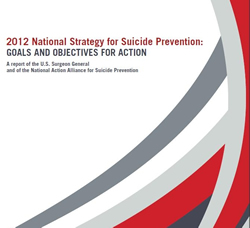Our Story
Launched on World Suicide Prevention Day (September 10) in 2010, the National Action Alliance for Suicide Prevention (Action Alliance) is an influential and productive national level public-private partnership charged with championing suicide prevention as a national priority.
- View brief video overview
- Read press release on Action Alliance and its goal
- Learn more about our partners and supporters
- Meet our team
Our Mission
 The Action Alliance is dedicated to advancing the National Strategy for Suicide Prevention, which presents the nation’s 13 goals and 60 objectives for suicide prevention.
The Action Alliance is dedicated to advancing the National Strategy for Suicide Prevention, which presents the nation’s 13 goals and 60 objectives for suicide prevention.
Through its unique ability to engage and unify passionate stakeholders and leaders in all sectors to collaborate toward a national and comprehensive approach to suicide prevention, the Action Alliance:
- Champions suicide prevention as a national priority
- Catalyzes efforts to implement high priority objectives of the National Strategy
- Cultivates the resources needed to sustain progress
Our Leadership
The Action Alliance is guided by a distinguished group of leaders from the public and private sectors who provide leverage and influence to prioritize suicide prevention at the national level. Sectors represented include automobile, construction, defense, education, entertainment, faith, forestry, health, insurance, justice, law enforcement, mental health, military, news media, professional sporting, railroad, technology, and veteran services.
Our Priorities
The Action Alliance is currently leading work in three priorities areas:
- Transforming health systems: Engage key stakeholders to improve and strengthen suicide care in our nation’s health systems
- Transforming communities: Support community-based efforts to implement effective suicide prevention strategies
- Changing the conversation: Ensure the dissemination of ethical and accurate messages that emphasize hope and recovery
Our Commitment
The Action Alliance is committed to:
- Developing, disseminating, and supporting the implementation of suicide prevention efforts in clinical and community settings (e.g., healthcare systems, faith communities, workplaces)
- Reaching groups at increased risk for suicide (e.g., American Indians and Alaska Natives, military service members, veterans)
- Ensuring that public messaging about suicide and suicide prevention is accurate, safe, helpful, and effective
- Engaging individuals with lived experience to inform and enhance future prevention strategies
- Improving national data systems for public health surveillance of suicide-related behavior
- Advancing implementation of the Action Alliance’s A Prioritized Research Agenda for Suicide Prevention